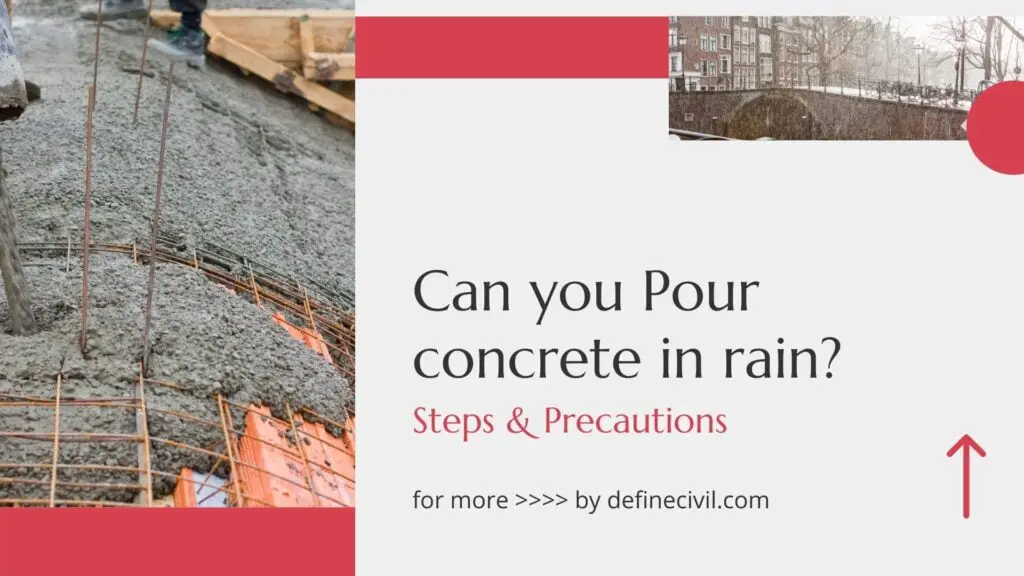There’s nothing like pouring your own concrete patio or driveway in order to personalize your home and create something functional you can use every day. However, concrete can be tricky to work with, especially if it rains while you’re pouring it. But not impossible if you’re cautious and prepared enough.
So, whether you’re pouring a driveway or are making foundation of your house and hoping that the concrete sets before it gets too wet outside, here’s how you deal with the rain.
Follow these steps to pour concrete in the rain successfully, without wasting any time or money on failed batches of concrete that get ruined by the wet weather.

Effect of excessive rain on concrete
All concrete, when mixed with water, takes on new strength and resistance, so after freshly mixed concrete has been placed, driving rain can ruin it. If you pour concrete in the rain, it is more likely to suffer from moisture or particles being driven in and breaking the bond, and increase the potential for scaling or dusting off.
When damage is done, it can be tough to rectify, and it often impacts the final product’s appearance. You’ll spoil your own festivities. These are some guidelines to prevent and fix rain-damaged concrete.
Also Read: Compaction of Concrete – Importance – Under- Over
Can you pour concrete in rain?
Surprisingly, yes, you can pour concrete in the rain. Though rain can have bad impact on the quality of concrete but still you can pour concrete in rain with proper steps.
Concrete does not dry, it cures. Rain will not damage curing concrete, as curing is a chemical reaction rather than a physical one. Despite a downpour, most often concrete cast underwater can cure just fine.
If dry weather and a little bit of preparation isn’t an option, it’s possible to pour concrete in the rain, but there are precautions to take.
Also Read: Can You Pour Concrete Over Concrete? – Level
Steps to pour concrete in rain
When rain is forecasted, reschedule your concrete pour, just in case it rains. Even if rain is not forecasted, be prepared to cover your work with a tarp or plastic sheeting just in case. Close the edges with protection to ensure water doesn’t leak inside.
Survey the exterior before beginning construction; also look for gutters and downspouts. Uncontrolled gushing from downspouts or spilling from overhanging roofs without gutters will wreak havoc on wet concrete if the ground below is immediately beneath the waterfall.
It is worth worrying about if there has been heavy rain, as it could lead to early water penetrations into the concrete slab before it has properly cured.
Tips for Handling Rain after Pouring Concrete
This is what you should do if it does rain on freshly poured concrete
- It’s important not to let the rainwater seep into the concrete surface, which is the biggest mistake you can make.
- Leave dry cement as an addition to absorb surface water; never use it to paint concrete to help with liquid mitigation.
- Make sure that, once the rain has passed, you push the remaining water off the edges of the slab before beginning to add any finishes.
- If there is standing water on the freshly poured concrete, this can ruin the concrete surface, leech cement out of the concrete, or produce other issues that would hamper the final project. To prevent this, make sure to remove any standing water before covering the concrete.
- Create proper drainage and contain water, then cover the surface with plastic sheeting, making sure to make sure that the water isn’t pooling underneath or on top of the new concrete.
Also Read: How to remove paint from concrete? – with or without chemicals
How Long Does Concrete Take to Dry Before Rain?
It may take rainwater several hours to be problematic after the concrete has set and the finishing process has been completed. If there was time to finish the process, and if the concrete is able to harden (typically after four to eight hours after being mixed), the rainwater may cause very little, if any, damage.
In fact, while concrete sets, rain water is beneficial to it because it assists in curing and water-proofing. Simply scratch the surface with a screwdriver or some kind of Mohs concrete surface hardness scratch test kit to figure out if the rain’s had any negative impact.
Before pouring a concrete slab, it’s important to understand how long it takes concrete to dry. The thickness of your concrete affects how long it will take to dry. With thinner slabs, your freshly poured concrete can take as little as 24 hours to dry before rainfall becomes an issue, while thicker slabs may take up to several days or even weeks.
There are some steps you can take to speed up drying time. For example, once you’ve poured your slab, cover it with plastic sheeting which will trap heat and moisture which allow cement to cure more quickly. Other options include creating a pattern of ditches across your surface that are 2 inches deep that facilitate rapid drainage of rainwater from beneath your new slab.
Also Read: Curing of Concrete- Methods- Temperature- Stages – Importance
Repairing concrete damaged by rain
The natural disintegration, or surface scaling, of concrete may happen due to weakening from rain at any point after the concrete has been put in place.
If your fresh-from-the-truck concrete gets wet while it’s still wet, the water will likely wash some of the wet cement off the surface.
As a result, problems like these are more likely to crop up:
- Dusting
- Surface scaling
- Craze cracking (easily aggravated by freeze-thaw cycles)
Unless the concrete is colored from the start, rain on the day of the pour can cause colors to bleed together, and make it difficult to apply the sealant or any other finishes.
Instead of having to remove the whole thing and start over, your best option is to grind off the top layer and overlay it with something stronger after ensuring that the original concrete is sound.
Also Read: What is concrete grinding? How to do it?














